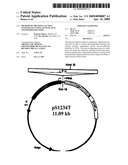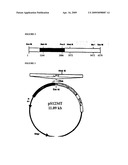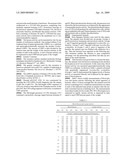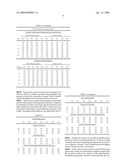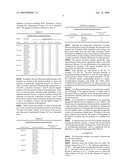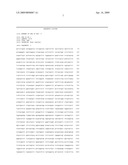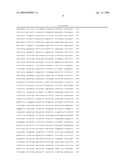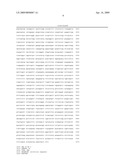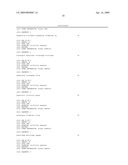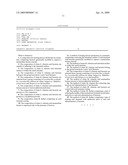Patent application title: METHOD OF TREATING LACTOSE INTOLERANCE USING GENETICALLY ENGINEERED BACTERIA
Inventors:
Kenneth Manzo (Shohola, PA, US)
Jay Sharma (San Pedro, CA, US)
IPC8 Class: AA61K3574FI
USPC Class:
424 932
Class name: Drug, bio-affecting and body treating compositions whole live micro-organism, cell, or virus containing genetically modified micro-organism, cell, or virus (e.g., transformed, fused, hybrid, etc.)
Publication date: 2009-04-16
Patent application number: 20090098087
Claims:
1. A composition for treating lactose intolerance in a mammal, comprising
bacteria genetically modified to express a mammalian lactase enzyme.
2. The composition of claim 1, wherein said bacteria are capable of adhering to the intestinal surface.
3. The composition of claim 2, wherein said intestinal surface is within the small intestine.
4. The composition of claim 1, wherein said bacteria belong to the group homolactic Lactic Acid Bacteria.
5. The composition of claim 4, wherein said bacteria are selected from a group consisting of Lactobacillus acidophilus, Lactobacillus delbrueckii subsp. bulgaricus, Bifidobacterium lactis and Streptococcus thermophilus.
6. The composition of claim 1, wherein said mammalian lactase enzyme is lactose-phlorizin hydrolase.
7. The composition of claim 1, wherein said bacteria are present as a live suspension.
8. The composition of claim 1, wherein said bacteria are present as a lyophilized powder.
9. The composition claim 8, further comprising an acid resistant coating.
10. The composition of claim 1, wherein said mammalian lactase is expressed only in the presence of lactose.
11. A method of treating lactose intolerance in a mammal, comprising contacting the intestinal surface of said mammal with bacteria genetically modified to express a mammalian lactase enzyme.
12. The method of claim 11, wherein said intestinal surface is within the small intestine.
13. The method of claim 11, wherein said bacteria belong to the group homolactic Lactic Acid Bacteria.
14. The composition of claim 3, wherein said bacteria are selected from a group consisting of Lactobacillus acidophilus, Lactobacillus delbrueckii subsp. bulgaricus, Bifidobacterium lactis and Streptococcus thermophilus.
15. The method of claim 11, wherein said mammalian lactase enzyme is lactose-phlorizin hydrolase.
16. The method of claim 11, wherein the contacting step involves oral administration of said bacteria.
17. The method of claim 11, wherein said bacteria are coated with acid resistant coating.
18. The method of claim 11, further comprising a step of reducing the acidity of the stomach environment in said mammal prior to said oral administration of bacteria.
19. The method of claim 11, further comprising a step of treating said mammal with antibiotics prior to said oral administration of bacteria.
Description:
BACKGROUND OF THE INVENTION
[0001]Lactose Intolerance
[0002]Dairy foods are an important source of protein, riboflavin and calcium for the United States, Europe, Asia, Africa and the many other areas of the world. However, many individuals suffer from lactose intolerance. This condition results from absence or insufficient production of the enzyme lactase. Acquired lactase deficiency is the most common disorder of complex carbohydrate absorption throughout the world, affecting up to 75% percent of the world's population. In the United States, 15% of Caucasians, over 50% of Hispanics and over 80% of African Americans suffer from lactose intolerance. The disorder is characterized by gastrointestinal symptoms of excessive gas production, abdominal pain, cramps, bloating and diarrhea after excessive consumption of lactose-containing foods such as dairy and dairy-based products.
[0003]In infancy, mammals have a high level of lactase activity in the lining of the upper intestinal tract, because they depend on lactose as the primary carbohydrate in their diet. However, in humans, the lactase expression is diminished by about 90% between ages two and five. This condition is called primary lactase deficiency. Many Northern Europeans, some Western Europeans, Mediterraneans and their descendants carry a mutation that prevents this natural decrease in lactase production. These individuals are able to consume milk as adults. However, large portions of the world population, such as Southern Europeans, East Asians and Sub-Saharan Africans have primary lactase deficiency.
[0004]Secondary lactase deficiency results from injury or disease of the small intestine. For example, celiac disease, inflammatory bowel syndrome (IBS) and Crohn's disease are often accompanied by lactase deficiency. These diseases occur in all ethnic groups.
[0005]Lactose Metabolism
[0006]Lactose is a disaccharide of glucose and galactose linked by a beta-D-glycosidic bond. The disaccharide is digested into its individual sugars by the lactase (beta-D-galactosidase) produced in the small intestine by the cells of the intestinal brush border. Glucose and galactose are absorbed in the small intestine. When lactase is absent from the small intestine, undigested lactose reaches the large intestine. There the resident bacteria metabolize lactose through fermentation generating gas. The gas is responsible for symptoms such as pain, pressure, cramps and flatulence. In addition, the undigested lactose increases osmotic pressure in the intestine, causing increased excretion of water and diarrhea.
[0007]Supplementing Lactase
[0008]There are several ways of delivering lactase to the gastrointestinal tract. As a simplest method, one can ingest a tablet of the isolated enzyme. Enzymes that break down lactose may be isolated from a variety of microorganisms, such as yeast, bacteria and fungi, such as Saccharomyces fragilis, Torula cermoris, Lactobacillus bulgaricus, Aspergillus oryzae, Aspergillus flavus and Asperillus niger. For example, U.S. Pat. No. 2,762,749 teaches preparing a lactase enzyme from budding yeast (Saccharomyces and Torula genuses) to supplement milk products where lactose crystallization is a problem. Lactase from fungi, such as Aspergillus, is described in U.S. Pat. No. 3,620,924. Isolating bacterial lactase (from the genus Bacillus) is described in U.S. Pat. Nos. 4,179,335, 4,237,230 and 4,323,651.
[0009]Several problems are associated with lactase replacement products. First, these products are not retained in the gastrointestinal tract. Lactase pills must be taken with each diary-containing meal. When the subject forgets to take the pill, or is unaware that food contains dairy, the symptoms of lactose intolerance are bound to recur.
[0010]Another problem is that many lactase enzymes from other species function poorly in the mammalian small intestine. The pH of the duodenum, where most of the normal lactose digestion occurs, is between 6.0 and 6.5. In contrast, as taught in the U.S. Pat. No. 6,562,339, a fungal lactase has a pH optimum of 4.8 and is only 10% active at pH 6.5. Many bacterial beta-galactosidases have a pH optimum above 7.0. Fortunately, a few enzymes from the Bacillus genus, as described for example, in U.S. Pat. No. 4,179,335, have a pH optimum near 6.0.
[0011]Another way to supplement lactase involves ingesting live or killed lactase-producing bacteria. For example, it is known that persons with mild lactose intolerance are able to tolerate yogurt but not milk, although both products contain the same amount of lactose. This is due to the fact that bacteria present in yogurt, such as Streptococcus thermophilus, Lactobacilli, Acidophilus and Bifidus species, express functional lactase. Thus, to improve the ability to digest lactose, one may consume yogurt products containing live and active cultures of these bacteria. Alternatively, one can ingest capsules that contain lyophilized live yogurt bacteria, as taught for example, in the U.S. Pat. No. 6,008,027. For an enhanced effect, bacteria can be combined with isolated lactase in the same enterically coated capsule, as taught in the U.S. Pat. No. 5,952,021 or Application Publication No. 2005/0100535.
[0012]Besides yogurt bacteria, other lactase-producing species can be used to improve lactose tolerance. For example, Korean researchers have isolated strains with lactase activity and good resistance to gastric acid. These strains come from Lactobacillus fermentum, (WIPO Publication KR3064030A), Lactococcus lactis (WIPO Publication KR4044300A) and Lactobacillus plantarum (WIPO Publication KR2088797A).
[0013]Unfortunately, physicians report limited success with treating lactose intolerance with naturally occurring bacterial cultures. The review of the literature conducted by family practitioners at the University of Pittsburg ("Do probiotics reduce adult lactose intolerance?" J Fam. Pract., 2005; v. 54, No. 7, p. 613-620) concluded that overall, the strategy was ineffective. The authors suggest that this is due to variation in bacterial viability and ability to produce lactase between the different dairy products and supplements. According to the study, with a few exceptions, most of these products do not provide sufficient lactase activity to alleviate the symptoms of lactose intolerance.
[0014]The symptoms of lactose intolerance were not relieved even when the most promising bacterium, Lactobacillus acidophilus was used. Among the yogurt bacteria, L. acidophilus has one of the highest natural levels of lactase and superior ability to adhere to the intestinal wall. Nevertheless, a Tufts University study "A randomized trial of Lactobacillus acidophilus BG2F04 to treat lactose intolerance", Am. J. Clin. Nutr. 1999, 69:140-146, concluded that even this bacterium was ineffective against the symptoms of lactose intolerance.
[0015]Using genetically-engineered bacteria to digest lactose is also known in the art. For example, U.S. Pat. No. 6,833,260 describes bacteria engineered to produce bacterial beta-galactosidase under the control of a constitutive promoter. Compared to the parent strain, the engineered bacteria produce more enzyme, although it is still of bacterial origin.
[0016]A more aggressive method of treating lactose intolerance involves gene therapy where the lactase gene is delivered directly into the cells of the intestinal wall, as described in U.S. Pat. No. 6,110,456. This method has several disadvantages. First, virus-driven gene therapy carries its own risks associated with the vector and the helper virus. Second, the target cells for the therapy, the intestinal epithelium, are constantly shedding. Unless the stem cells at the base of the inner layer of the intestinal wall are transformed with the new gene, the expression of lactase will be temporary. The newly emerging layers of intestinal cells would need to be repeatedly retransformed with another dose of the gene.
[0017]In summary, there is a need for a safe but long-lasting treatment of lactose intolerance. Ideally, one treatment would last for months without re-application. An ideal treatment would involve a lactase enzyme optimized for action under the conditions found in the mammalian small intestine.
SUMMARY OF THE INVENTION
[0018]The present invention relates to genetically engineered bacteria that are able to colonize the mammalian intestine and actively produce mammalian enzymes for the hydrolysis of lactose. The lactose-digesting enzymes are stable and active under the conditions normally found in the mammalian small intestine.
DEFINITIONS
[0019]"Small intestine" is the part of the gastrointestinal tract between the stomach and the large intestine. In vertebrate animals, small intestine is composed of duodenum, jejunum, and ileum.
[0020]"Large intestine" is the final part of the gastrointestinal tract in vertebrate animals.
[0021]"Resident bacteria" or "resident bacterial microflora" refers to bacteria that naturally colonize a host organ, such as gastrointestinal tract, or genetically altered strains of such bacteria.
[0022]"Gene" is the segment of DNA involved in producing a polypeptide chain; it includes regions preceding and following the coding sequence.
[0023]"Polypeptide" or "protein" is a polymer of amino acid residues encoded by at least a portion of the coding sequence of the gene.
[0024]"Enzymatically active protein" refers to a polypeptide that has enzymatic activity i.e. can catalyze specific chemical reactions of the proper substrates under proper conditions either within or outside of a cell where the polypeptide is produced.
[0025]"Genetically engineered bacteria" refers to bacterial cells that replicate a heterologous nucleic acid, or express a polypeptide encoded by a heterologous nucleic acid.
[0026]"Heterologous nucleic acid" is one that originates from a source foreign to the particular host cell, or, if from the same source, is modified from its original form.
[0027]"Promoter" is a nucleic acid sequence that acts as a signal sequence necessary to initiate transcription of a gene.
[0028]"Gene expression" as referred to in this application is the transcription (production of mRNA) followed by translation (production of a polypeptide encoded by the gene).
[0029]"Plasmid" is circular double-stranded DNA molecule, separate from chromosomal DNA and capable of autonomous replication and stable propagation in the host cell.
[0030]"Lactic acid bacteria" is a group of bacterial species comprised of Gram positive, low-GC-content, acid tolerant, non-sporulating, non-respiring rods or cocci that produce lactic acid as the major metabolic end-product of carbohydrate fermentation. This group includes the genera of Lactobacillus, Leuconostoc, Pediococcus, Lactococcus, Streptococcus, Aerococcus, Carnobacterium, Enterococcus, Oenococcus, Teragenococcus, Vagococcus, and Weisella.
[0031]"Homolactic lactic acid bacteria" are a subgroup of lactic acid bacteria that catabolize one mole of glucose through glycolysis (Embden-Meyerhof-Parnas (EMP) pathway) to yield two moles of pyruvate that is further reduced to lactate. This subgroup includes the genera of Lactococcus, Enterococcus, Streptococcus and Pediococcus.
BRIEF DESCRIPTION OF THE DRAWINGS
[0032]FIG. 1 is a map of the plasmid pS1234T.
[0033]FIG. 2 is a detailed map of the insert in the plasmid pS1234T.
DETAILED DESCRIPTION OF THE INVENTION
[0034]The present invention provides intestine-colonizing bacteria, such as for example, Lactobacillus acidophilus, that are genetically altered to express mammalian lactase activity. Using genetically-engineered lactic acid bacteria has several advantages over the prior art method of lactase supplementation. First, bacteria are able to self-replicate while retaining the inserted lactase gene. Second, lactic acid bacteria are normally present in milk and yogurt have been proven safe over the millennia since humans have been ingesting these foods.
[0035]Bacterial Strains
[0036]The preferred embodiment involves the use of bacterium Lactobacillus acidophilus, however other related or similar species found in dairy products may also be used. The suitable bacteria belong to the group homolactic Lactic Acid Bacteria (LAB). Representative homolactic LAB genera include Lactococcus, Enterococcus, Streptococcus, Pediococcus and group I lactobacilli. Common examples from this group include Lactobacillus acidophilus, Lactobacillus delbrueckii subsp. bulgaricus (often referred to as L. bulgaricus), Bifidobacterium lactis and Streptococcus thermophilus.
[0037]Lactobacillus acidophilus was originally isolated from feces of infants. It can also be isolated from mouth and vagina of children and adults. In other animals, this bacterium can be found in the intestinal tract of turkeys and chickens and mouth and intestinal tract of rats and hamsters. A strain of this species is available from American Tissue Culture Collection (ATCC) as #53544. The strain was transformed with a recombinant genetic construct incorporating a coding sequence for a mammalian lactase.
[0038]Lactase Gene
[0039]The mammalian gene selected for this invention is a human gene encoding lactase-phlorizin hydrolase (LPH) (Mantei, et al., EMBO J. 7:2705-2713 (1988)). LPH, sometimes called small-intestinal lactase, is a major digestive enzyme in the small intestine of newborns. The enzyme is first synthesized as a 215-245 kDa precursor, comprising four tandemly repeated domains (I-IV). Proteolytic cleavage of the precursor separates LPH-alpha (domains I-II), devoid of enzymatic function, and liberates the mature enzyme, LPH-beta consisting of domains III and IV. LPH-beta has enzymatic activity and is anchored to the membrane via a C-terminal hydrophobic segment.
[0040]The lactase activity can be measured in vitro by any number of well-known methods. One method utilizes O-nitrophenyl-beta-D-galactopyranoside (ONPG) as a substrate and spectrophotometrically measures the product O-nitrophenol (ONP). The amount of ONP is then divided by the reaction time and the weight of the reaction mixture or the number of cells in the reaction. A unit of lactase activity can be expressed in umol ONP/min per gram of dry weight.
[0041]Genetic Construct
[0042]The invention utilizes standard molecular biology techniques described in Sambrook et al., Molecular Cloning, A Laboratory Manual (3rd. ed., 2001).
[0043]The genetic construct used for this invention is based on a plasmid vector pRLU61, capable of replicating in Gram-positive bacteria. See Jost et al., Biochem. J. 327:95-103 (1997).
[0044]The mRNA sequence of human LPH (in the cDNA form) has a Genebank accession no. X07994, and is reproduced below as SEQ. ID NO. 1.
[0045]Plasmid pS1234T (FIG. 1) was constructed by inserting the LPH cDNA (EcoRI fragment) into the unique EcoRI site of pRLU61. The full-length cDNA sequence of LPH was cloned as described in the Examples section. In the pS1234T, the LPH coding sequence is driven by a constitutive CMV promoter.
[0046]The full-length precursor of LPH (domains I-IV) contained a proteolytic cleavage signal between domains II and III. When introduced into the host cells, the precursor was cleaved by the host proteases as evidenced by the appearance of measurable lactase activity. The plasmid produced expression of LPH in both prokaryotic and eukaryotic cells, including rat epithelial cells and Chinese hamster ovary (CHO) cells and bacterial cells as further described below.
[0047]Experimental Animals
[0048]Rats (Sprague Dawley) were used for this experiment. The animals were divided into six groups: Groups A and B received no treatments and served as controls. Groups C and D ingested genetically engineered Lactobacillus acidophilus. Groups E and F ingested wild-type Lactobacillus acidophilus. In Groups C and E, prior to ingestion of the bacteria, the animal's gut was flushed with antibiotics for a day. Then the bacteria were ingested on the following day. This treatment enables the bacteria to gain competitive advantage over the preexisting microflora and take up residence in the small intestine.
[0049]After bacteria were given time to colonize the intestine, the animals were fed lactose-containing foods and their blood glucose level was monitored. At the same time, blood lactase activity was measured spectrophotometrically using ONPG as a substrate. As shown in Table 1, animals colonized with genetically engineered Lactobacillus acidophilus (Groups C and D) demonstrated the highest levels of lactase activity as measured directly and evidenced by the appearance of blood glucose.
[0050]Table 1 shows weekly measurements of blood glucose and lactase activity following the initial ingestion of bacteria. After a 12-hour overnight fast, the animals were fed lactose-containing food. A duplicate measurement was taken at each of the indicated time points in minutes after the animals consumed lactose-containing food. The measurements were taken weekly for five weeks (W1-W5). Blood glucose is expressed in mg/dL, lactase activity is expressed in units equal to umol ONP/min per gram of dry weight
TABLE-US-00001 TABLE 1 Blood Glucose and Lactase Activity Blood Glucose Lactase Activity Min W1 W2 W3 W4 W5 W1 W2 W3 W4 W5 Group C (antibiotics pre-treatment and GE bacteria) 0 125 125 125 125 125 110 110 110 110 110 125 125 125 125 125 110 110 110 110 110 30 160 161 160 160 160 116 120 120 120 120 160 160 161 161 175 116 121 120 120 120 60 175 177 170 175 180 135 135 136 136 136 175 177 170 176 181 135 136 136 136 136 90 180 185 180 180 190 130 130 130 130 130 180 185 182 180 190 130 130 130 130 130 120 190 190 190 190 190 140 142 140 140 140 190 190 191 190 190 140 142 140 140 140 Group D (GE bacteria) 0 125 125 125 125 125 110 110 110 110 110 125 125 125 125 125 110 110 110 110 110 30 160 160 160 160 160 130 130 130 130 128 160 160 160 160 160 130 130 130 130 128 60 185 185 180 180 180 160 160 160 160 160 185 185 180 180 180 160 160 160 160 160 90 185 180 180 180 180 180 180 180 180 180 185 180 180 180 180 180 180 180 180 180 120 180 180 185 185 180 180 180 180 180 180 180 180 185 185 180 180 180 180 180 180 Group E (antibiotics pre-treatment and wild-type bacteria) Blood Glucose, mg/dL Lactase Activity Min W1 W2 W3 W4 W5 W1 W2 W3 W4 W5 0 125 125 125 125 125 110 110 110 110 110 125 125 125 125 125 110 110 110 110 110 30 140 140 135 130 130 120 125 125 120 120 140 140 135 130 130 120 125 125 121 120 60 160 160 161 160 160 130 130 130 135 130 160 160 160 160 160 130 130 130 135 130 90 170 170 171 170 170 140 145 145 140 140 170 170 170 170 170 140 145 145 141 140 120 175 175 172 170 170 140 145 140 140 145 175 174 173 175 170 140 145 145 140 141 Group F (wild-type bacteria) Blood Glucose, mg/dL Lactase Activity Minutes W1 W2 W3 W4 W5 W1 W2 W3 W4 W5 0 125 125 125 125 125 110 110 110 110 110 125 125 125 125 125 110 110 110 110 110 30 135 135 135 135 135 125 120 125 125 125 135 135 135 135 135 125 120 125 125 125 60 160 170 160 160 160 135 130 130 128 130 160 170 160 160 160 135 130 130 128 130 90 170 150 160 160 160 140 135 138 135 135 170 150 160 160 160 140 135 138 135 135 120 175 175 165 165 165 140 145 135 135 135 175 175 165 165 165 140 145 135 135 135
[0051]Next, lactase activity in the stool was measured. As shown in Table 2, animals colonized with genetically engineered Lactobacillus acidophilus (Groups C and D) demonstrated the highest levels of lactase activity in the stool.
[0052]Table 2 shows weekly measurements of stool lactase activity following the initial ingestion of bacteria. A duplicate measurement was taken each week. The measurements were taken weekly for seven weeks (W1-W7). Lactase activity is expressed in units equal to umol ONP/min per gram of dry weight. The gender of the animals is also indicated as M or F.
TABLE-US-00002 TABLE 2 Stool Lactase Activity W1 W2 W3 W4 W5 W6 W7 Group A (Control) M 110 110 110 110 110 110 110 M 110 110 110 110 110 109 109 F 110 110 110 110 110 109 109 F 110 110 110 110 110 110 109 Group B (Control) M 110 110 110 109 110 110 110 M 110 110 110 109 110 110 110 F 109 110 110 110 110 110 110 F 109 110 110 110 110 110 110 Group C (antibiotics pre-treatment and GE bacteria) M 202 200 202 202 202 202 202 M 202 200 202 202 202 202 202 F 202 201 201 202 202 202 202 F 202 201 201 202 202 202 202 Group D (GE bacteria) M 175 175 172 172 169 169 165 M 175 175 172 172 169 169 165 F 175 175 172 172 169 169 164 F 175 175 172 172 169 169 164 Group E (antibiotic pre-treatment and wild-type bacteria) M 150 150 149 150 136 136 136 M 150 150 149 149 136 136 136 F 150 149 150 150 136 136 136 F 150 149 150 150 136 136 136 Group F (wild-type bacteria) M 160 160 160 160 135 138 135 M 160 160 160 160 135 138 135 F 160 160 160 160 138 137 135 F 160 160 160 160 138 138 135
[0053]Finally, the animals were sacrificed and the intestinal lactase activity was measured directly. As shown in Table 3, animals colonized with genetically engineered Lactobacillus acidophilus (Groups C and D) demonstrated the highest levels of lactase activity in the extracts.
[0054]Table 3 shows lactase activity in umol ONP/min per gram of dry weight. For each animal a sample was taken from the stomach as well as two sections of the small intestine: duodenum and jejunum. The time is measured after the consumption of lactose-containing foods, following a 12-hour overnight fast. Experimental Groups A-F are as described above. The gender of animals is indicated as M or F.
TABLE-US-00003 TABLE 3 Lactase Activity in Intestinal Sections Study Intestinal Lactase activity Group sections 0 min 60 min 90 min 120 min Group A Stomach 0.09 0.08 0.06 0.03 Duodenum 0.07 0.81 0.60 0.10 Jejunum 0.04 0.13 0.14 0.16 Group B Stomach 0.08 0.09 0.05 0.04 Duodenum 0.08 0.91 0.81 0.10 Jejunum 0.04 0.14 0.15 0.16 Group C Stomach 0.65 0.60 0.75 0.65 Duodenum 0.44 0.89 0.95 1.04 Jejunum 0.33 1.44 1.52 1.67 Group D Stomach 0.65 0.63 0.60 0.65 Duodenum 0.44 0.90 0.99 1.05 Jejunum 0.35 1.45 1.55 1.70 Group E Stomach 0.42 0.45 0.50 0.40 Duodenum 0.35 0.70 0.80 0.95 Jejunum 0.20 0.99 1.02 1.30 Group F Stomach 0.36 0.39 0.40 0.40 Duodenum 029 0.69 0.71 0.92 Jejunum 0.20 0.98 1.01 1.20
[0055]In addition, the microflora from different parts of the intestine was plated on the nutrient medium to assess the numbers of genetically engineered bacteria. As shown in Table 4, animals colonized with genetically engineered Lactobacillus acidophilus (Groups C and D) had the highest numbers of lactase-positive bacteria in the duodenum. There were no lactase-positive bacteria in the duodenum of the untreated animals (Groups A and B). Animals treated with wild-type Lactobacillus acidophilus (Groups E and F) had fewer lactase-positive bacteria in the duodenum than Groups C and D. In addition, Group C had the highest number of lactase-positive bacteria in the jejunum.
[0056]Table 4 shows the number of colony-forming units (CFUs) recovered from the intestinal extracts of each animal. The male and female animals in each group were used for each data point. Experimental Groups A-F are as described above.
TABLE-US-00004 TABLE 4 Bacteria Recovered from Intestinal Sections Bacterial counts Study Group Intestinal sections CFU/ml Group A Stomach 0 Duodenum 0 Jejunum 10 Group B Stomach 0 Duodenum 0 Jejunum 25 Group C Stomach 0 Duodenum 10 Jejunum 30 Group D Stomach 0 Duodenum 15 Jejunum 25 Group E Stomach 0 Duodenum 5 Jejunum 10 Group F Stomach 0 Duodenum 6 Jejunum 15
[0057]Although the background information describes lactose intolerance in relation to humans, the invention is not meant to be so limited. Other mammals, such as dogs, cats and rodents suffer from the same type of primary lactose intolerance in adulthood. Thus one of ordinary skill in the art would be able to use the teachings of this invention to develop a similar treatment of lactose intolerance in such mammals.
[0058]The present invention teaches genetically engineered bacteria that must be ingested in order to aid in the digestion of lactose. For oral administration, the composition containing the bacteria of the present invention may be enclosed in an enterically coated capsule.
[0059]Such capsules are well known in the art. For example, U.S. Pat. No. 5,633,012 describes methods of microencapsulating lyophilized lactobacilli using alginate, polyacryl and a variety of other organic polymers. U.S. Pat. No. 5,952,021 teaches encapsulating bacteria in a methylacrylate-based polymers sold under the brand names EUDRAGIT S® and EUDRAGIT L®. These polymers are insoluble in acid, but dissolve at neutral pH found in the small intestine.
[0060]As is demonstrated above, to maximize the competitive advantage of the ingested bacteria, a subject may be pre-treated with an antibiotic before the bacterial culture is administered. Suitable antibiotics are, for example amoxicillin and neomycin
[0061]As an alternative to lyophilization, the genetically engineered bacteria may be ingested as a live culture. The bacteria may be suspended in nutrient medium or prepared as a dairy product. Such products containing live bacteria are well known in the art. For example, Bio-K+ International, Inc. of Laval, Quebec, sells 1/2 oz cups of a yogurt-like product that contains a concentrated culture (up to 50 billion) of live and active cultures of lactobacilli. The cultures of the bacteria of the present invention may be prepared as a similar dairy product.
[0062]To maximize the survival of live cultures during the passage through the stomach, a subject may be pre-treated with a simple antacid such as baking soda or Alka-Seltzer® or an acid-reducing medication, such as omperazole sold by Merck & Co. under the brand name PRILOSEC®.
EXAMPLES
[0063]The following examples are meant to illustrate but not limit the invention.
[0064]Bacterial Strains
[0065]Bacterial strain was isolated from raw milk. The cultures were grown at 37° C. The optimum temperature is 35-38° C. The upper limit of temperature tolerance is about 48° C., the lower limit is above 22° C., as no significant growth is observed at 22° C. Growth occurs at initial pH values between 5.0 and 7.0, but the optimum pH range is 5.5-6.0.
[0066]The cultures were grown in Terrific Broth medium (per liter: 12 g bacto-tyrptone, 24 g yeast extract, 4 ml glycerol, 0.017M KH2PO4, 0.072M K2HPO4). Biochemical characteristics of this species are as follows: it metabolizes arginine into ammonia; ferments lactose into galactose and glucose, which in turn is further fermented into lactic acid; and also ferments amygdalin, cellobiose, fructose, galactose and maltose.
[0067]Genetic Construct
[0068]The plasmid pS1234T for expression in L. acidophilus was obtained by first assembling an insert (FIG. 2) in an E. coli plasmid PLPH. The plasmid PLPH was prepared in six steps.
[0069]First, screening of an intestinal cDNA library resulted in isolation of a 2,400 bp clone that contained a BamHI/PvuII fragment encompassing the putative LPH cleavage site. The BamHI/PvuII fragment was isolated for cloning.
[0070]Second, an EcoRI/BamHI fragment, corresponding to the nucleotides 1-1244 of the LPH cDNA was amplified by PCR using oligonucleotides LPH1 (SEQ ID NO. 2) and cLPH1300 (SEQ. ID NO. 3). This fragment was cloned into a commercially available vector pGEM4Z, generating a plasmid pLPH1. pLPH1 contained nucleotides 1-1244 of LPH cDNA.
[0071]Third, a PvuII/HindIII fragment corresponding to the nucleotides 2886-3572 of the LPH cDNA was amplified by PCR using oligonucleotides LPH2841 (SEQ ID NO. 4) and cLPH3600 (SEQ. ID NO. 5). This PvuII/HindIII fragment and the isolated BamHI/PvuII fragment described in the first paragraph of this section were cloned by three-way ligation into pLPH1, using the BamHI and HindIII sites, generating a plasmid pLPH2. pLPH2 contained nucleotides 1-3572 of LPH cDNA.
[0072]Fourth, a HindIII/StyI fragment corresponding to the nucleotides 3572-5472 of the LPH cDNA was amplified by PCR using oligonucleotides LPH3541 (SEQ ID NO. 6) and cLPH5470 (SEQ. ID NO. 7).
[0073]Fifth, an StyI/EcoRI fragment corresponding to the nucleotides 5472-6270 of the LPH cDNA was amplified by PCR using oligonucleotides LPH5461 (SEQ ID NO. 8) and cLPH6270 (SEQ. ID NO. 9). This StyI/EcoRI fragment and the HindIII/StyI fragment described in the preceding paragraph were cloned by three-way ligation into pGEM4Z, using the EcoRI and HindIII sites, generating a plasmid pLPH3. pLPH3 contained nucleotides 3572-6270 of LPH cDNA.
[0074]Finally, the EcoRI/HindIII fragment from pLPH2 (nucleotides 1-3572 of LPH cDNA) and the HindIII/EcoRI fragment from pLPH3 (nucleotides 3572-6270 of LPH cDNA) were ligated in a three-way ligation into the EcoRI site of pGEM4Z, generating pLPH. The plasmid pLPH contained a full cDNA sequence of LPH.
TABLE-US-00005 LPH1 (SEQ ID NO. 2) 5'-AAAGAATTCGTTCCTAGAAAATGGAGCTGTCTTGGCATGTAG-3'; cLPH1300 (SEQ ID NO. 3) 5'-CTGGCCACCTCCAGCGTCGCTTGGC-3' LPH2841 (SEQ ID NO. 4) 5'-AAAGACAATGCCACTGGAGACATCG-3' cLPH3600 (SEQ ID NO. 5) 5'-TGAACCTCTTCTCTTCCTCAGTGAA-3' LPH3541 (SEQ ID NO. 6) 5'-AACTGCAGCACTTAGCCACCTCCCG-3' cLPH5470 (SEQ ID NO. 7) 5'-ATGCTTTGGGGATCCTTGGCAAGAGA-3' LPH5461 (SEQ ID NO. 8) 5'-ACCCTTCTCTGCCAAGGATCCCCAA-3' cLPH6270 (SEQ ID NO. 9) 5'- AAAAGAATTCGGACAGTCTTCTGTTTTTATTTTCGGAAAA-3'
[0075]For experimental expression in mammalian cells, the full-length PH sequence (EcoRI fragment containing nucleotides 1-6270) was subcloned into the EcoRI site of pCMV2 (Invitrogen, Carlsbad, Calif.) to generate pS1234T (FIG. 1).
[0076]Experimental Animals
[0077]Sprague Dowley rats were housed under standard conditions and fed a standard diet. Water was given ad libitum. For Groups D and F, the animals were pre-treated with amoxicillin or neomycin. For all groups, except control groups A and B, a suspension of bacterial cells was given with yogurt as food.
[0078]At the end of 14 weeks the animals were sacrificed. The following parameters were measured during the course of the study: blood glucose concentration, lactase activity in the blood and stool, blood pH and total body weight. At the end of the study, lactase activity in the intestinal contents and the composition of intestinal microflora were also measured.
[0079]Measuring Blood Glucose Concentration
[0080]To measure blood glucose concentration, blood was taken from the tail vein. 0.7 ml was collected from each animal. The test was done using a blood glucose meter.
[0081]Measuring Blood, Stool and Intestinal Lactase Activity
[0082]The lactase activity was determined by United States Pharmacopeia (USP) method (USP27, official monograph pages 1062-1063). The stool was dispersed in buffer prior to the assay. Sections of the intestine were dissected and the contents were dispersed in buffer prior to the assay.
Counting the Number of Lactococci in the Intestine
[0083]The numbers of genetically engineered lactococci and wild-type lactococci were measured by suspending the intestinal contents and plating serial dilution of the suspensions on solid medium. The lactococci were detected by microscopic examination of the bacterial flora under Olympus inverted microscope based on the bacterial cell's morphology. The genetically engineered lactococci were detected.
[0084]The above examples are provided to illustrate the invention and not to limit its scope. Other variants of the invention will be readily apparent to one of ordinary skill in the art and are encompassed by the appended claims.
Sequence CWU
1
916274DNAHomo sapiens 1gttcctagaa aatggagctg tcttggcatg tagtctttat
tgccctgcta agtttttcat 60gctgggggtc agactgggag tctgatagaa atttcatttc
caccgctggt cctctaacca 120atgacttgct gcacaacctg agtggtctcc tgggagacca
gagttctaac tttgtagcag 180gggacaaaga catgtatgtt tgtcaccagc cactgcccac
tttcctgcca gaatacttca 240gcagtctcca tgccagtcag atcacccatt ataaggtatt
tctgtcatgg gcacagctcc 300tcccagcagg aagcacccag aatccagacg agaaaacagt
gcagtgctac cggcgactcc 360tcaaggccct caagactgca cggcttcagc ccatggtcat
cctgcaccac cagaccctcc 420ctgccagcac cctccggaga accgaagcct ttgctgacct
cttcgccgac tatgccacat 480tcgccttcca ctccttcggg gacctagttg ggatctggtt
caccttcagt gacttggagg 540aagtgatcaa ggagcttccc caccaggaat caagagcgtc
acaactccag accctcagtg 600atgcccacag aaaagcctat gagatttacc acgaaagcta
tgcttttcag ggcggaaaac 660tctctgttgt cctgcgagct gaagatatcc cggagctcct
gctagaacca cccatatctg 720cgcttgccca ggacacggtc gatttcctct ctcttgattt
gtcttatgaa tgccaaaatg 780aggcaagtct gcggcagaag ctgagtaaat tgcagaccat
tgagccaaaa gtgaaagttt 840tcatcttcaa cctaaaactc ccagactgcc cctccaccat
gaagaaccca gccagtctgc 900tcttcagcct ttttgaagcc ataaataaag accaagtgct
caccattggg tttgatatta 960atgagtttct gagttgttca tcaagttcca agaaaagcat
gtcttgttct ctgactggca 1020gcctggccct tcagcctgac cagcagcagg accacgagac
cacggactcc tctcctgcct 1080ctgcctatca gagagtctgg gaagcatttg ccaatcagtc
cagagcggaa agggatgcct 1140tcctgcagga tactttccct gaaggcttcc tctggggtgc
ctccacagga gcctttaacg 1200tggaaggagg ctgggccgag ggtgggagag gggtgagcat
ctgggatcca cgcaggcccc 1260tgaacaccac tgagggccaa gcgacgctgg aggtggccag
cgacagttac cacaaggtag 1320cctctgacgt cgccctgctt tgcggcctcc gggctcaggt
gtacaagttc tccatctcct 1380ggtcccggat cttccccatg gggcacggga gcagccccag
cctcccaggc gttgcctact 1440acaacaagct gattgacagg ctacaggatg cgggcatcga
gcccatggcc acgctgttcc 1500actgggacct gcctcaggcc ctgcaggatc atggtggatg
gcagaatgag agcgtggtgg 1560atgccttcct ggactatgcg gccttctgct tctccacatt
tggggaccgt gtgaagctgt 1620gggtgacctt ccatgagccg tgggtgatga gctacgcagg
ctatggcacc ggccagcacc 1680ctcccggcat ctctgaccca ggagtggcct cttttaaggt
ggctcacttg gtcctcaagg 1740ctcatgccag aacttggcac cactacaaca gccatcatcg
cccacagcag caggggcacg 1800tgggcattgt gctgaactca gactgggcag aacccctgtc
tccagagagg cctgaggacc 1860tgagagcctc tgagcgcttc ttgcacttca tgctgggctg
gtttgcacac cccgtctttg 1920tggatggaga ctacccagcc accctgagga cccagatcca
acagatgaac agacagtgct 1980cccatcctgt ggctcaactc cccgagttca cagaggcaga
gaagcagctc ctgaaaggct 2040ctgctgattt tctgggtctg tcgcattaca cctcccgcct
catcagcaac gccccacaaa 2100acacctgcat ccctagctat gataccattg gaggcttctc
ccaacacgtg aaccatgtgt 2160ggccccagac ctcatcctct tggattcgtg tggtgccctg
ggggataagg aggctgttgc 2220agtttgtatc cctggaatac acaagaggaa aagttccaat
ataccttgcc gggaatggca 2280tgcccatagg ggaaagtgaa aatctctttg atgattcctt
aagagtagac tacttcaatc 2340aatatatcaa tgaggtgctc aaggctatca aggaagactc
tgtggatgtt cgttcctaca 2400ttgctcgttc cctcattgat ggcttcgaag gcccttctgg
ttacagccag cggtttggcc 2460tgcaccacgt caacttcagc gacagcagca agtcaaggac
tcccaggaaa tctgcctact 2520ttttcactag catcatagaa aagaacggtt tcctcaccaa
gggggcaaaa agactgctac 2580cacctaatac agtaaacctc ccctccaaag tcagagcctt
cacttttcca tctgaggtgc 2640cctccaaggc taaagtcgtt tgggaaaagt tctccagcca
acccaagttc gaaagagatt 2700tgttctacca cgggacgttt cgggatgact ttctgtgggg
cgtgtcctct tccgcttatc 2760agattgaagg cgcgtgggat gccgatggca aaggccccag
catctgggat aactttaccc 2820acacaccagg gagcaatgtg aaagacaatg ccactggaga
catcgcctgt gacagctatc 2880accagctgga tgccgatctg aatatgctcc gagctttgaa
ggtgaaggcc taccgcttct 2940ctatctcctg gtctcggatt ttcccaactg ggagaaacag
ctctatcaac agtcatgggg 3000ttgattatta caacaggctg atcaatggct tggtggcaag
caacatcttt cccatggtga 3060cattgttcca ttgggacctg ccccaggccc tccaggatat
cggaggctgg gagaatcctg 3120ccttgattga cttgtttgac agctacgcag acttttgttt
ccagaccttt ggtgatagag 3180tcaagttttg gatgactttt aatgagccca tgtacctggc
atggctaggt tatggctcag 3240gggaatttcc cccaggggtg aaggacccag gctgggcacc
atataggata gcccacaccg 3300tcatcaaagc ccatgccaga gtctatcaca cgtacgatga
gaaatacagg caggagcaga 3360agggggtcat ctcgctgagc ctcagtacac actgggcaga
gcccaagtca ccaggggtcc 3420ccagagatgt ggaagccgct gaccgaatgc tgcagttctc
cctgggctgg tttgctcacc 3480ccatttttag aaacggagac tatcctgaca ccatgaagtg
gaaagtgggg aacaggagtg 3540aactgcagca cttagccacc tcccgcctgc caagcttcac
tgaggaagag aagaggttca 3600tcagggcgac ggccgacgtc ttctgcctca acacgtacta
ctccagaatc gtgcagcaca 3660aaacacccag gctaaaccca ccctcctacg aagacgacca
ggagatggct gaggaggagg 3720acccttcgtg gccttccacg gcaatgaaca gagctgcgcc
ctgggggacg cgaaggctgc 3780tgaactggat caaggaagag tatggtgaca tccccattta
catcaccgaa aacggagtgg 3840ggctgaccaa tccgaacacg gaggatactg ataggatatt
ttaccacaaa acctacatca 3900atgaggcttt gaaagcctac aggctcgatg gtatagacct
tcgagggtat gtcgcctggt 3960ctctgatgga caactttgag tggctaaatg gctacacggt
caagtttgga ctgtaccatg 4020ttgatttcaa caacacgaac aggcctcgca cagcaagagc
ctccgccagg tactacacag 4080aggtcattac caacaacggc atgccactgg ccagggagga
tgagtttctg tacggacggt 4140ttcctgaggg cttcatctgg agtgcagctt ctgctgcata
tcagattgaa ggtgcgtgga 4200gagcagatgg caaaggactc agcatttggg acacgttttc
tcacacacca ctgagggttg 4260agaacgatgc cattggagac gtggcctgtg acagttatca
caagattgct gaggatctgg 4320tcaccctgca gaacctgggt gtgtcccact accgtttttc
catctcctgg tctcgcatcc 4380tccctgatgg aaccaccagg tacatcaatg aagcgggcct
gaactactac gtgaggctca 4440tcgatacact gctggccgcc agcatccagc cccaggtgac
catttaccac tgggacctac 4500cacagacgct ccaagatgta ggaggctggg agaatgagac
catcgtgcag cggtttaagg 4560agtatgcaga tgtgctcttc cagaggctgg gagacaaggt
gaagttttgg atcacgttga 4620atgagccctt tgtcattgct taccagggct atggctacgg
aacagcagct ccaggagtct 4680ccaataggcc tggcactgcc ccctacattg ttggccacaa
tctaataaag gctcatgctg 4740aggcctggca tctgtacaac gatgtgtacc gcgccagtca
aggtggcgtg atttccatca 4800ccatcagcag tgactgggct gaacccagag atccctctaa
ccaggaggat gtggaggcag 4860ccaggagata tgttcagttc atgggaggct ggtttgcaca
tcctattttc aagaatggag 4920attacaatga ggtgatgaag acgcggatcc gtgacaggag
cttggctgca ggcctcaaca 4980agtctcggct gccagaattt acagagagtg agaagaggag
gatcaacggc acctatgact 5040tttttgggtt caatcactac accactgtcc tcgcctacaa
cctcaactat gccactgcca 5100tctcttcttt tgatgcagac agaggagttg cttccatcgc
agatcgctcg tggccagact 5160ctggctcctt ctggctgaag atgacgcctt ttggcttcag
gaggatcctg aactggttaa 5220aggaggaata caatgaccct ccaatttatg tcacagagaa
tggagtgtcc cagcgggaag 5280aaacagacct caatgacact gcaaggatct actaccttcg
gacttacatc aatgaggccc 5340tcaaagctgt gcaggacaag gtggaccttc gaggatacac
agtttggagt gcgatggaca 5400attttgagtg ggccacaggc ttttcagaga gatttggtct
gcattttgtg aactacagtg 5460acccttctct gccaaggatc cccaaagcat cagcgaagtt
ctacgcctct gtggtccgat 5520gcaatggctt ccctgacccc gctacagggc ctcacgcttg
tctccaccag ccagatgctg 5580gacccaccat cagccccgtg agacaggagg aggtgcagtt
cctggggcta atgctcggca 5640ccacagaagc acagacagct ttgtacgttc tcttttctct
tgtgcttctt ggagtctgtg 5700gcttggcatt tctgtcatac aagtactgca agcgctctaa
gcaagggaaa acacaacgaa 5760gccaacagga attgagcccg gtgtcttcat tctgatgagt
taccacctca agttctatga 5820agcaggccta gtttcttcat ctatctttac cggccaccaa
acaccttagg gtcttagact 5880ctgctgatac tggacttctc cataaagtcc tgctgcaccg
ttagagatga ctttaatctt 5940gaatgatttc gacttgctga gtaaaatgga aatatctcca
tcttgctcca gtatcagagt 6000tcatttgggc atttgagaag caagtagctc ttgcggaaac
gtgtagatac tggtctagtg 6060ggtctgtgaa ccacttaatt gaacttaaca gggctgtttt
aagtttcaga gttgttaagg 6120gttgttaagg gagcaaaaac cgtaaaaatc cttcctataa
gaagaaatca actccattgc 6180atagactgca atatcatctc ctgcccttct gcaagctctc
cctagcttca catcttgtgt 6240tttccagaaa ataaaaacag aagactgtcc tttc
6274242DNAartificial sequencePrimer LPH1
2aaagaattcg ttcctagaaa atggagctgt cttggcatgt ag
42340DNAartificial sequencePrimer CLPH1300 3ttgcatgcat aagcttaaat
ttctgtcgga ttccccagtc 40425DNAartificial
sequencePrimer LPH2841 4aaagacaatg ccactggaga catcg
25525DNAartificial sequencePrimer CLPH3600
5tgaacctctt ctcttcctca gtgaa
25625DNAartificial sequencePrimer LPH3541 6aactgcagca cttagccacc tcccg
25726DNAartificial sequencePrimer
CLPH5470 7atgctttggg gatccttggc aagaga
26825DNAartificial sequencePrimer LPH5461 8acccttctct gccaaggatc
cccaa 25940DNAartificial
sequencePrimer CLPH6270 9aaaagaattc ggacagtctt ctgtttttat tttcggaaaa
40
User Contributions:
Comment about this patent or add new information about this topic:
| People who visited this patent also read: | |
| Patent application number | Title |
|---|---|
| 20140114003 | MOLDED PRODUCT, MOLDING MATERIAL, OPTICAL COMPONENT, AND METHOD OF PRODUCING MOLDING MATERIAL |
| 20140114002 | DIELECTRIC COMPOSITION FOR THIN-FILM TRANSISTORS |
| 20140114001 | GLASS FIBER-REINFORCED POLYCARBONATE FLAME-RETARDANT RESIN COMPOSITION |
| 20140114000 | FLAMEPROOFED ALICYCLIC POLYIMIDE RESIN COMPOSITION AND THIN-WALLED MOLDED BODY OF SAME |
| 20140113999 | REDUCED COLOR EPOXIDIZED ESTERS FROM EPOXIDIZED NATURAL FATS AND OILS |

